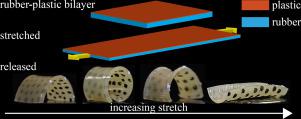Extreme Mechanics Letters ( IF 4.7 ) Pub Date : 2021-06-10 , DOI: 10.1016/j.eml.2021.101384 Rahul G. Ramachandran , Jonah de Cortie , Spandan Maiti , Luca Deseri , Sachin S. Velankar

|
Polymeric plastics deform irreversibly (i.e., inelastically) whereas rubbers deform reversibly, i.e., elastically. Thus, uniaxially stretching a rubber-plastic bilayer composite beyond its yield point can create an elastic strain mismatch between the two layers. Upon release, the bilayer may then bend out-of-plane. We quantify the mechanics of such stretch-release-induced shape changes in rectangular specimens of rubber-plastic bilayers. We show a remarkable dependence of the final shape upon the stretch applied prior to release. At small stretch, all bilayers bend into arch or roll shapes with the plastic on the convex face. At large stretch, the bilayers bend into half-tubes with the plastic, now heavily-wrinkled, becoming the concave face. Thus, the sign and direction of the curvature both flip as applied stretch increases. Between these two extremes, saddle shapes appear which have characteristics of both arches as well as half-tubes. Sufficiently narrow samples show different behavior: they transition from arches to helices as stretch increases. All these shapes are mono-stable. We document numerous ways in which the mechanics of rubber-plastic bilayers differs from that of fully-elastic bilayers. Most importantly, yielding of the plastic layer during the shape change strongly affects the mechanics of the elastic–plastic bilayers, and yielding accompanied by plastic wrinkling has an especially large effect. A strain energy model illustrates how the shape change is dictated by the change in the ratio of elastic strain mismatch in the two directions due to the formation of wrinkles at the rubber-plastic interface.
中文翻译:

橡胶-塑料双层的单轴拉伸释放:应变依赖过渡到稳定的螺旋、辊、鞍形和管
聚合物塑料不可逆地(即非弹性)变形,而橡胶则可逆地变形,即弹性变形。因此,单轴拉伸橡胶-塑料双层复合材料超过其屈服点会在两层之间产生弹性应变失配。释放后,双层可以弯曲出平面。我们量化了橡胶-塑料双层矩形试样中这种拉伸释放引起的形状变化的力学。我们展示了最终形状对释放前施加的拉伸的显着依赖性。在小范围内,所有双层都弯曲成拱形或卷曲形状,塑料在凸面上。在较大的拉伸下,双层弯曲成半管,塑料现在皱巴巴的,变成凹面。因此,当施加的拉伸增加时,曲率的符号和方向都翻转。在这两个极端之间,出现了具有拱形和半管特征的马鞍形状。足够窄的样品表现出不同的行为:随着拉伸的增加,它们从拱形过渡到螺旋形。所有这些形状都是单稳态的。我们记录了橡胶-塑料双层的力学与全弹性双层的力学不同的多种方式。最重要的是,塑性层在形状变化过程中的屈服强烈影响弹塑性双层的力学,并且伴随塑性起皱的屈服具有特别大的影响。应变能模型说明了由于在橡胶-塑料界面处形成皱纹,两个方向上的弹性应变失配比率的变化如何决定形状变化。出现了具有拱形和半管特征的马鞍形状。足够窄的样品表现出不同的行为:随着拉伸的增加,它们从拱形过渡到螺旋形。所有这些形状都是单稳态的。我们记录了橡胶-塑料双层的力学与全弹性双层的力学不同的多种方式。最重要的是,塑性层在形状变化过程中的屈服强烈影响弹塑性双层的力学,并且伴随塑性起皱的屈服具有特别大的影响。应变能模型说明了由于在橡胶-塑料界面处形成皱纹,两个方向上的弹性应变失配比率的变化如何决定形状变化。出现了具有拱形和半管特征的马鞍形状。足够窄的样品表现出不同的行为:随着拉伸的增加,它们从拱形过渡到螺旋形。所有这些形状都是单稳态的。我们记录了橡胶-塑料双层的力学与全弹性双层的力学不同的多种方式。最重要的是,塑性层在形状变化过程中的屈服强烈影响弹塑性双层的力学,并且伴随塑性起皱的屈服具有特别大的影响。应变能模型说明了由于在橡胶-塑料界面处形成皱纹,两个方向上的弹性应变失配比率的变化如何决定形状变化。足够窄的样品表现出不同的行为:随着拉伸的增加,它们从拱形过渡到螺旋形。所有这些形状都是单稳态的。我们记录了橡胶-塑料双层的力学与全弹性双层的力学不同的多种方式。最重要的是,塑性层在形状变化过程中的屈服强烈影响弹塑性双层的力学,并且伴随塑性起皱的屈服具有特别大的影响。应变能模型说明了由于在橡胶-塑料界面处形成皱纹,两个方向上的弹性应变失配比率的变化如何决定形状变化。足够窄的样品表现出不同的行为:随着拉伸的增加,它们从拱形过渡到螺旋形。所有这些形状都是单稳态的。我们记录了橡胶-塑料双层的力学与全弹性双层的力学不同的多种方式。最重要的是,塑性层在形状变化过程中的屈服强烈影响弹塑性双层的力学,并且伴随塑性起皱的屈服具有特别大的影响。应变能模型说明了由于在橡胶-塑料界面处形成皱纹,两个方向上的弹性应变失配比率的变化如何决定形状变化。我们记录了橡胶-塑料双层的力学与全弹性双层的力学不同的多种方式。最重要的是,塑性层在形状变化过程中的屈服强烈影响弹塑性双层的力学,并且伴随塑性起皱的屈服具有特别大的影响。应变能模型说明了由于在橡胶-塑料界面处形成皱纹,两个方向上的弹性应变失配比率的变化如何决定形状变化。我们记录了橡胶-塑料双层的力学与全弹性双层的力学不同的多种方式。最重要的是,塑性层在形状变化过程中的屈服强烈影响弹塑性双层的力学,并且伴随塑性起皱的屈服具有特别大的影响。应变能模型说明了由于在橡胶-塑料界面处形成皱纹,两个方向上的弹性应变失配比率的变化如何决定形状变化。


























 京公网安备 11010802027423号
京公网安备 11010802027423号